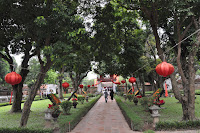(...)
We strolled along the Ho Tai lake while heading towards the Quan Thanh Temple. Quite often people asked to take photos with us and more than often making out the "V" of victory. Ines being the one with the lightest skin complexion was often photographed as well.


To go across took us a certain amount of time, as drivers in Vietnam, siniliarly to a few other countries in Asia are not particularly considerate in regards to the pedestrians and even when Minh, our guide stretched both his arms and conducted our "crossing" one had to pay attention.
Reputed to have been patronized by Emperor Ly Thao To the Quan Thanh Temple has been dedicated to Tran Vo, the guardian of the North - a Taoist Divinity. It is a mixture of several styles pertaining to the imperial era. In its courtyard there is a brick oven where people often burn fake money.
It was quite interesting to look at architecturally speaking, I felt.
It was quite interesting to look at architecturally speaking, I felt.






We then walked towards the Temple of Literature built in 1070 in the time of the same Emperor, being one of the several temples in Vietnam dedicated to Confucius, sages and scholars.
Vietnam's first University known as the Imperial Academy was established within the Temple premises in 1076 to educateVietnam's bureaucrats, nobles royalty and elite members.
The main gate opens onto three pathways which continue through the Temple ensemble, the centre path having been reserved for the monarch. The first two courtyards are quiet areas with well trimmed lawns where the scholars were expected to relax.
The second courtyard contains the Constellation of Literature Pavilion built on white-washed stillts. The 1805 ornate gate stands as a reflection of Van Mieu's brilliant literary legacy.
The third courtyard is dominated by the Well of Heavenly Clarity. On both sides of the pond there are buildings which house 82 stone stelae, mounted on giant tortoise pedestals. On them one can see the names and brief personal details of scholars who passed Van Mieu's examinations. Most of them date from the 15th to the 18th centuries.
Bai Duon or the House of Ceremonies hosts the elaborately decorated alter of Confucius, flanked by statues of cranes standing up on tortoises - an auspicious symbol.
Located just behind the Bai Duong is a long red laquered and gilt Temple to Confucius, whose statue dressed in rich robes of red and gold can be seen surounded by four of his maind disciples.
The ensemble was corwded with school children of all ages distributed by groups and once more (we were getting used to) we were asked to take some photos with locals, who find it auspicious










I wish I hadn't forgotten the Mandarin characters I learned some years back because it would have been handy to further get into the spirit of some of the Chinese written information.
We still had time to stroll around the Temple's bookshop but there was nothing special to buy. So far I hadn't really come across any interesting Vietnames books translated in English, apart from some Cuisine ones, though i was hopeful I would before getting back home.





















No comments:
Post a Comment